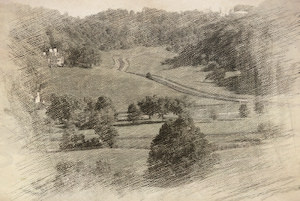
While Nashville is the economic, educational, and tourism hub of Middle Tennessee, there is much to discover outside of the Nashville City limits. Middle Tennessee is home to friendly people and beautiful scenery. The area has over a dozen state parks, numerous lakes, and historic homes. Weekend adventure seekers can always find a spot to add to their "must see" lists in Middle Tennessee.
A Few of Middle Tennessee's Most Popular Lakes

J. Percy Priest LakeThe locals simply call it Percy Priest Lake.The 14,200 acre lake covers portions of Davidson, Rutherford and Wilson Counties. Percy Priest is surrounded by 18,854 acres of public land; much of that land is devoted to wildlife management. The lake has three public camp grounds, along with multiple marinas and picnic areas. The Nashville Shores Water Park is located on the shores of Percy Priest Lake and is a major draw for locals and tourists. Percy Priest is home to The Tennessee Boat Club, The Vanderbilt Sailing Club, The Vanderbilt Rowing Club, and The Nashville Rowing Club.
Old Hickory LakeFormed by the Old Hickory Lock and Dam on the Cumberland River,the 22,500 acre lake covers portions of Davidson, Sumner, Wilson, Trousdale and Smith Counties. It includes eight marinas, two campgrounds, and forty-one boat access sites, all of which are operated by the Army Corps of Engineers . Many of Middle Tennessee's most beautiful homes are perched on the banks of Old Hickory Lake. One of the most famous lake estates was the home of Johnny Cash and June Carter Cash. Unfortunately , the 13,880 Square foot Cash home was destroyed by fire during a 2007 renovation by then owner, Barry Gibb.
Center Hill LakeCenter Hill lake is a reservoir lake constructed by the Army Corps of Engineers in 1948.Center Hill is located near Smithville, Tennessee, a little over an hour from Nashville. The lake covers 18,220 acres. Edgar Evins, Burgess Falls, and Rock Island State Parks are located along portions of Center Hill's shoreline. In addition to the parks, Center Hill lake features seven marinas, ten boat ramps , and several campgrounds.
Tims Ford LakeLocated about an hour and a half from Nashville, Tims Ford is a reservoir lake that is run by the Tennessee Valley Authority.The 10,700 acre lake rests within portions of Franklin and Moore counties and covers 10,700 acres of land. On the lake's northern shore sits the 2,200 acre Tims Ford State Park. The park includes two campgrounds, two Pavilions, a marina and an 18 hole golf course designed by Jack Nicklaus. The lake is situated largely within the town of Winchester, TN. Winchester is a picturesque southern town, known for its beautifully preserved and maintained downtown shopping district. Tims Ford Lake is also within a few miles of the plateau town of Sewanee, which is home to the The University of the South.
A Few of Middle Tennessee's Most Popular State Parks

Bicentennial Capitol Mall State ParkBicentennial Capitol Mall State Park lies beneath the shadow of the Tennessee State Capitol in downtown Nashville. While not the largest state park in Middle Tennessee, it's arguably the most educational. The park gives visitors a sampling of Tennessee's history. Bicentennial Park features a 200 foot granite map of the State, a World War II Memorial, a 95-bell carillon, a Pathway of History, and The Rivers of Tennessee Fountains. The Walkway of Counties features native plant species from different regions of Tennessee. The park occupies land that was spared during the building boom that occurred in downtown Nashville during the 1950s. Because of its swampy nature, the site was unsuitable for building skyscrapers. The last view of Tennessee's impressive Capitol building, not obstructed by skyscrapers or other large buildings, is on full display at Bicentennial Capitol Mall State Park. The park is also the site of Nashville's New Years Eve Celebration.
Cedars of Lebanon State ParkCedars of Lebanon is located in Wilson County, just over thirty miles from Nashville.The Park is part of the Cedars of Lebanon State Forest and spans 1,139 acres. It has eight miles of hiking trails that weave through cedar forests and limestone glades. The park's limestone glades help create an environment that is home to nineteen rare and endangered plant species that grow nowhere else in the world. It features 117 campsites, all are equipped with picnic tables, grills, electric hookups and water hookups. The park's group lodge accommodates up to eighty people and is open year round for large groups and organizations.
Dunbar Cave State ParkDunbar Cave has a rich history.The park is located about sixty miles northwest of Nashville, and one and half miles northeast of downtown Clarksville in Montgomery County. The Cave itself is surrounded by a 144 acre park with tranquil walking trails and the 15-acre Swan Lake. Swan Lake is a natural lake fed by the cold, clear water that flows from the mouth of Dunbar Cave. Fishing is not allowed in Swan Lake. Dunbar Cave is named for Thomas Dunbar whose family was the first to live on the property. The entrance to Dunbar Cave has a year round temperature of 58 degrees. During the 1930s, the cave hosted local bands and other types of entertainment. In 1948, Country Music Legend, Roy Acuff bought the property. Acuff broadcasted his "Saturday Night Radio Dance" program from the cave. In 1973, Tennessee Governor Winfield Dunn purchased the property and designated it a State Natural Area.
Henry Horton State ParkAn hour from Nashville in Chapel Hill, Tennessee,Henry Horton State Park sits on the estate of former Governor Henry Horton. Horton served as Tennessee's Governor from 1927 to 1933. The park rests along the shore of the Duck River. On the park's Wilhoite Mill Trail, visitors can find a few pieces of Horton family history. The trail is home to the century old ruins of a mill and bridge that were used by the family of Horton's wife, Adeline Wilhoite Horton. The park has several lodging options, including an inn, eight cabins, fifty-six RV campsites, ten tent campsites, nine primitive campsites, three back country campsites, and three group sites. Accommodations also include the full service Governor's Table Restaurant. Henry Horton State Park is home to the Buford Ellington Championship Golf Course, Duck River fishing, and the Henry Horton Trap and Skeet Range. The park affords meeting and event spaces that can be rented by groups and organizations.
A Few of Middle Tennessee's Most Popular Historic Homes

The HermitageThe Hermitage sits on 1,120 acres approximately ten miles from downtown Nashville.It is the historic home of Andrew Jackson, the seventh president of the United States. Jackson lived at the Hermitage from 1804 until his death in 1845. The original Hermitage Mansion was constructed between 1819 and 1821. That home burned in 1834, while Jackson was away in Washington, D.C. Jackson had the home that stands today built on the foundation of the original mansion in 1835. After Jackson's death and the Civil War, The Hermitage fell on hard times and was sold to the State of Tennessee. The last members of the Jackson family vacated the home in 1893 and The Hermitage was opened to the public. Andrew Jackson and his wife, Rachel, are buried on the property. The Hermitage was declared a National Historic Landmark in 1960. The home receives over 250,000 visitors per year and can be toured daily.
James K. Polk HomeBuilt in 1816, The James K. Polk Home is the only surviving private residence of the eleventh President of the United States, James K. Polk.The home is just an hour outside of Nashville, in Columbia, Tennessee. Once the wealthiest city in Tennessee, Columbia has more surviving Pre-Civil War homes than any city in the state. The Polk Home was built by President Polk's father, Samuel Polk. President Polk lived in the home for six years as a young adult. While residing in the White House, President Polk purchased the Nashville Mansion of former Tennessee Attorney General, Felix Grundy. He named that home Polk Place. After his Presidency, President and Mrs. Polk returned to the Columbia home for several months while Polk Place was being renovated. President Polk died in Nashville at Polk Place in 1849. His widow, Sarah Childress Polk, continued to reside at Polk Place until her death in 1891. Mrs. Polk left Polk Place and its contents to her great niece, Sallie Fall. After legal disputes over President Polk's will, Mrs. Fall was forced to abandon Polk Place and it was ultimately demolished in 1901. Mrs.Fall did retain the belongings of President and Mrs. Polk. Nashville's Capital Hotel now sits on the former site of Polk Place. Mrs. Fall and her daughter, Saidee Grant, founded the James K. Polk Association in 1924. With the help of the State of Tennessee, they purchased the Polk Residence in Columbia. Many of the Polk family items inherited by Mrs. Fall were moved to the James K. Polk Home in Columbia and are on display there today.
CheekwoodCheekwood, a fifty-five acre estate in West Nashville, was built by Leslie Cheek and his wife Mabel Wood Cheek.It can be said that coffee built this impressive Georgian Manor Home. Leslie Cheek's cousin, Joel Owsley Cheek, developed an acclaimed blend of coffee that was marketed and branded through Nashville's finest hotel, the Maxwell House Hotel. Leslie Cheek and Mabel were primary investors in Maxwell House Coffee's parent company. In 1928, Maxwell House Coffee was sold to Postum Cereal Company for more than $40 Million. Following the sale, Leslie Cheek purchased 100 acres of woodland and hired New York Architect, Bryant Flemming, to design the home and the surrounding gardens. The 30,000 square foot limestone mansion was completed in 1932. Leslie Cheek died two years later, but Mabel and their daughter, Huldah Cheek Sharp, continued to live at Cheekwood through the 1950s. Huldah, and her husband envisioned the property for use as a botanical garden and art museum. The Cheekwood Museum opened in 1960. Today Cheekwood houses an extensive collection of art , and the botanical gardens cover the entire 55-acre site. Cheekwood is open year round for visitors to tour the gardens and exhibits. In 2000, Cheekwood was added to the National Register of Historic Places and It remains a Middle Tennessee treasure.


